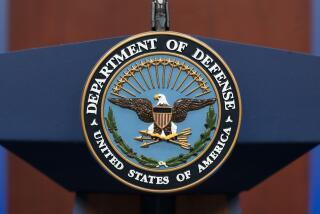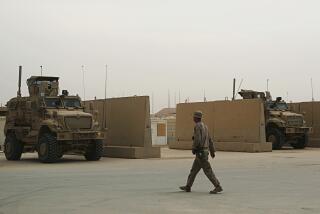Obama’s plan: Send 30,000 new troops to Afghanistan, begin leaving by July 2011
Reporting from Washington and West Point — President Obama has ordered the deployment of 30,000 additional U.S. troops to Afghanistan, officials said today, yet the president also will announce tonight that the U.S. will begin withdrawing forces from the country in July 2011.
The reinforcements will be sent to Afghanistan by the summer, senior administration officials said today -- with 30,000 new troops boosting an existing U.S. deployment of 68,000 troops in the country.
The president will announce his decision in a nationally televised speech at the U.S. Military Academy at West Point. The speech, officials said, will focus not only on the new troops entering the country, but also on the administration’s plan to withdraw those forces.
The administration will begin to withdraw the reinforcements by July 2011, senior administration officials said. The pace of that draw-down and the end point of it will be determined by “conditions on the ground” that cannot be currently predicted, one official said.
“This is not an open-ended commitment ... all of us have to have a sense of urgency,” said one senior administration official said.
“Starting in July 2011, we will begin to transfer authority to Afghan forces,” an administration official said, “but the rate at which we draw down the troops has not been prescribed.” That rate will be “conditions-based,” the official said, “with an eye towards full transfer as quickly as possible.”
The administration was emphasizing that it is not sending combat forces to the war zone indefinitely, but wants to show a long-term commitment of broader support to Afghanistan.
The goal of the troop buildup is to “degrade” Taliban forces in Afghanistan, prevent the Taliban from taking over the nation and also prevent Al Qaeda from returning to Afghanistan, allowing time for the Afghan security forces to become more competent, officials said.
During a prolonged strategy review, the military proposed sending in additional forces over the course of a year. But officials said that the course which the president has chosen will deliver more troops to Afghanistan more swiftly.
“The force option that the president has chosen gets more troops into Afghanistan faster than any other option that was presented to him,” one senior administration official said.
The decision came at the end of a three-month review of strategy for the 8-year-old war.
Although conducted behind closed doors in the White House’s Situation Room, parts of the debate played out in an unusually public manner, with officials briefing reporters on the outlines of the debate.
Vice President Joe Biden and Karl Eikenberry, the U.S. ambassador to Afghanistan, were skeptical about the troop buildup. During the debate, Biden made the case that the focus should be on Pakistan and advocated sending fewer troops to Afghanistan and instead using unmanned drones and airstrikes to disrupt Taliban operations in more rural areas.
But senior military leaders, including Adm. Michael G. Mullen, the chairman of the Joint Chiefs of Staff, and Gen. Stanley A. McChrystal, the top U.S. commander in Afghanistan, pushed for a higher number of troops.
Defense Secretary Robert M. Gates helped work out a compromise that brought McChrystal’s request for 40,000 troops down by 10,000.
Today, an administration official said that all of the officials involved in the discussions had signed on to the final compromise. There were no “winners and losers in this debate,” the official said.
Gates is due to sign deployment orders for the troops going into Afghanistan later this week. The troops will be sent to Khost in eastern Afghanistan as well as to Kandahar and Helmand provinces in southern Afghanistan.
The forces pouring into eastern and southern Afghanistan will seek to undermine the Taliban in part by luring low-level fighters and foot soldiers to abandon extremist movements.
The administration plan envisions trying to shift the loyalty of low-level fighters to tribal leaders by offering them jobs in security forces. That strategy borrows from the military strategy in Iraq, where insurgents were given paid jobs in neighborhood defense forces.
A military official said the focus on flipping low-level fighters was an important “component of where we are headed.”
In meetings during the strategy review, senior military officials insisted that, because improved security was a precondition for winning the loyalties of foot soldiers and fence-sitters, adding forces was necessary for such initiatives to work.
“What you are talking about are the fence-sitters, the ones who support the Taliban not by choice but by fear,” said the military official. “You want to supplant that fear with security.”
The senior officials said the new deployment will include two or three combat brigades. In addition, a “brigade-sized element” -- about 3,500 forces -- will be sent as trainers. But the senior administration official emphasized that all of the forces would be partnered with Afghan security forces to assist with training.
Although Obama’s speech will focus mostly on Afghanistan, officials said the review also looked at Pakistan and emphasized the importance of assisting Pakistan with security and economic issues.
“We need to help the Pakistanis stabilize their state,” said one senior administration official.
Military experts have cautioned that setting a concrete timetable to leave Afghanistan could enable the Taliban to outlast the U.S. combat forces. But the military officials said the Taliban would minimize the U.S. commitment to Afghanistan at “its own risk.”
Peter Nicholas and Mark Silva contributed reporting from Washington.
More to Read
Get the L.A. Times Politics newsletter
Deeply reported insights into legislation, politics and policy from Sacramento, Washington and beyond. In your inbox three times per week.
You may occasionally receive promotional content from the Los Angeles Times.











